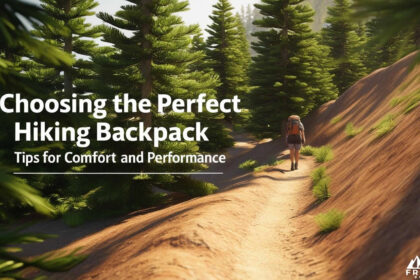
Discover essential tips for selecting the perfect hiking backpack to enhance comfort and performance on your outdoor adventures.
Importance of Choosing the Right Backpack for Hiking
Selecting the right backpack is essential for comfort and efficiency on hikes. A well-fitted backpack with suitable features can significantly enhance your hiking experience, preventing discomfort that can detract from the enjoyment of nature. For instance, a hiker equipped with a properly sized and well-structured backpack can traverse rugged terrains without feeling the strain of poorly distributed weight, allowing for longer and more enjoyable hikes. When hiking, the right backpack can mean the difference between a pleasant adventure and an exhausting day filled with aches and pains.
Moreover, the right backpack can improve your overall performance by distributing weight evenly across your body. This is crucial because uneven weight distribution can lead to fatigue and even injury. For example, a hiker using a backpack that fits well and has a good frame design can maintain better posture and balance, thus increasing their endurance on long trails. Additionally, a properly sized backpack allows for better ventilation and comfort, which is particularly important in warm weather or during physically demanding hikes. This attention to detail in selecting the right backpack can greatly enhance one’s hiking experience.
Understanding Backpack Capacity
Backpack capacities vary widely, typically ranging from 30 to 80 liters, depending on the length of the trip. For day hikes, a backpack capacity of 20 to 30 liters is generally sufficient, providing ample space for essentials like water, snacks, and a first-aid kit. For instance, a hiker embarking on a day trip to a nearby mountain might find a 25-liter pack ideal, as it can comfortably hold all necessary gear without excess weight. This size allows for easy maneuverability and less bulk, which is crucial during short, energetic hikes.
When planning for longer hikes, such as weekend or multi-day trips, choosing a backpack with a capacity of 30 to 50 liters or 50 to 80 liters becomes necessary. A weekend trip to a national park might require a 50-liter pack to accommodate sleeping gear, cooking supplies, and ample food. If you’re a minimalist who prefers packing only the essentials, a smaller pack will suffice. However, if you prefer to carry additional gear, such as cooking equipment or extra clothing, you may need a larger option to accommodate your needs. Understanding your personal packing style and the type of trips you plan will help guide your choice, ensuring that you’re well-prepared for your adventures.
Types of Backpack Frames
When choosing a backpack, the frame type is a critical factor. Internal frame backpacks are often preferred for their stability and weight distribution, making them ideal for hiking on varied terrains. For example, a hiker traversing steep, rocky paths with an internal frame pack will benefit from its ability to keep the weight close to the body, enhancing balance and agility. The design of internal frames allows for a more modern approach to load carriage, which can lead to a more comfortable hiking experience, especially on challenging trails.
On the other hand, external frame backpacks are advantageous for carrying heavy or irregular loads, often favored by hunters for their capacity to hold larger items securely. These packs allow for better ventilation and can be adjusted to accommodate bulky gear, making them suitable for specific outdoor pursuits like hunting or extended camping trips. Frameless backpacks, while lightweight, require careful packing to ensure comfort during hikes. Hybrid models, which combine features of both internal and external frames, offer versatility, accommodating different hiking conditions and personal preferences. Choosing the right frame type can greatly affect your comfort and performance on the trail, making it an essential consideration.
Key Features to Look For
When selecting a hiking backpack, certain features can enhance comfort and functionality. Adjustable hip belts are a must, as they help distribute weight effectively and enhance overall comfort during long hikes. For instance, a hiker with a well-adjusted hip belt can carry more weight without straining their shoulders or back. This feature becomes even more crucial when navigating uneven terrain or steep inclines, where proper weight distribution can significantly impact balance and stability.
Additional features to consider include side water bottle pockets for quick hydration access and hydration bladders for easy water management during activities. A removable daypack can also be beneficial for short excursions from the main camp, allowing hikers to leave their larger pack behind while still carrying necessary essentials. Pockets and compartments should be strategically placed to ensure easy organization and access to gear, which can save time and energy on the trail. Moreover, consider packs with built-in rain covers or waterproof materials, ensuring your gear stays dry during unexpected weather changes. These thoughtful features can enhance your outdoor experiences, allowing you to focus on enjoying nature rather than managing gear.
Proper Fit and Sizing
Achieving the right fit for a hiking backpack is crucial for comfort and efficiency. It begins with measuring your torso length and hip circumference to find a pack that suits your body shape. Women-specific packs are designed with shorter torso dimensions and contoured straps, enhancing comfort for female hikers. A properly fitted backpack can help reduce the risk of chafing and discomfort, allowing you to enjoy long hikes without the distraction of an ill-fitting pack.
Adjustments such as load-lifter straps and sternum straps are also important, as they help improve stability and prevent shifting during movement. A general rule of thumb is to ensure that the total weight of the backpack does not exceed 20-25% of your body weight, which is key to maintaining comfort and preventing injury during hikes. Taking the time to try on different sizes and making necessary adjustments can be the difference between a successful hiking adventure and an uncomfortable experience. Remember, a good fit not only enhances comfort but also improves your overall performance on the trail, making it essential to prioritize this aspect when choosing a backpack.
Packing Strategies
Effective packing strategies can maximize space in your hiking backpack. Organizing gear by weight is essential; heavier items should be packed closer to your back to maintain balance. For example, placing a sleeping bag at the bottom of the pack and heavier items above it can help distribute weight evenly. This method allows for a lower center of gravity, making it easier to navigate difficult terrains.
Using compression sacks and dry bags can also aid in organizing and maximizing space. A dedicated sleeping bag compartment allows for easy access to your sleeping bag without unloading other gear, which can be particularly convenient during overnight trips. Additionally, keeping frequently used items in easily accessible pockets reduces the need to rummage through the entire pack, streamlining your experience on the trail. Consider packing a small emergency kit or snack bag in an outer pocket for immediate access, which can be particularly beneficial during longer hikes. These simple yet effective packing strategies can enhance your overall hiking efficiency, allowing you to focus on the adventure ahead.
Testing the Backpack
Before making a purchase, it is essential to test the backpack to ensure it fits well. Visiting local gear outfitter stores allows you to try on different models and sizes. Ideally, you should fill the pack with some weight to get a sense of how it will feel during a hike. Walking around the store while mimicking hiking movements can help you assess comfort and stability. Taking the time to test multiple backpacks can reveal nuances in fit and comfort that may not be apparent when simply trying them on without weight.
Testing the pack with your gear is also recommended to ensure proper fit and load distribution, ideally having 60-80% of the weight resting on your hips. This practical approach ensures that you are fully satisfied with your choice before taking it on your outdoor adventures. Don’t hesitate to ask for advice from store staff, as they often have valuable insights and can help you find the best pack based on your specific needs and intended hiking activities. The right testing process can lead to greater satisfaction and performance on the trails.
Maintenance and Care
Regular maintenance and cleaning of your hiking backpack can prolong its lifespan and ensure it remains in good condition. Specific cleaning products and methods should be used to keep the materials intact. After each trip, inspect your backpack for wear and tear, which can help prevent future issues and ensure your gear is always ready for the next adventure. Checking zippers, seams, and fabric for any signs of damage can save you from unpleasant surprises during a hike.
It’s also important to store your backpack in a cool, dry place away from direct sunlight, as prolonged exposure can degrade materials over time. Cleaning your pack after particularly muddy or wet hikes can prevent mold and odors from developing, ensuring a more pleasant experience on your next outing. Consider using a backpack-specific cleaner or a gentle soap to maintain the fabric without causing damage. By taking these steps, you can maintain the functionality and aesthetics of your backpack, making it a reliable companion for many hikes to come.
Renting vs. Buying
For those unsure about which backpack to purchase, renting is a cost-effective option that allows you to try different models before committing to a buy. Many outdoor retailers offer rental services, providing the opportunity to test various sizes and styles to determine what works best for your hiking style and preferences. Renting can be particularly beneficial for specific trips, such as a short hiking excursion or for those who may not hike frequently enough to justify purchasing a new pack.
Consider renting for specific trips or when testing out new hiking styles to determine what works best for you. For instance, if you’re planning a multi-day trek but are unsure about the best pack for the journey, renting one first can give you insight into what features you value most. This experience can help you make a more informed decision regarding your purchase, ensuring you choose a backpack that meets all your needs. The option to rent first allows you to explore different brands and styles, ultimately leading to a more satisfying purchase decision.
Summary of Key Considerations
Choosing the right backpack is a personal decision based on individual needs, hiking style, and the type of trips planned. It is crucial to invest time in selecting the right gear, as it can significantly enhance comfort and performance on the trail. Consider both short-term needs and long-term durability when making a decision, ensuring that your backpack will serve you well on many adventures to come. Emphasizing the importance of comfort, fit, and functionality will lead to more enjoyable experiences on the trails, making your hiking adventures even more fulfilling.



